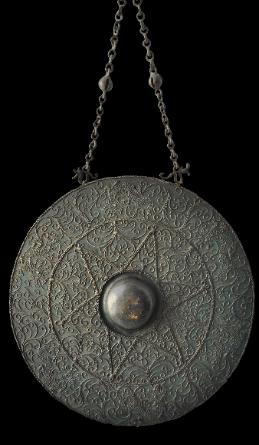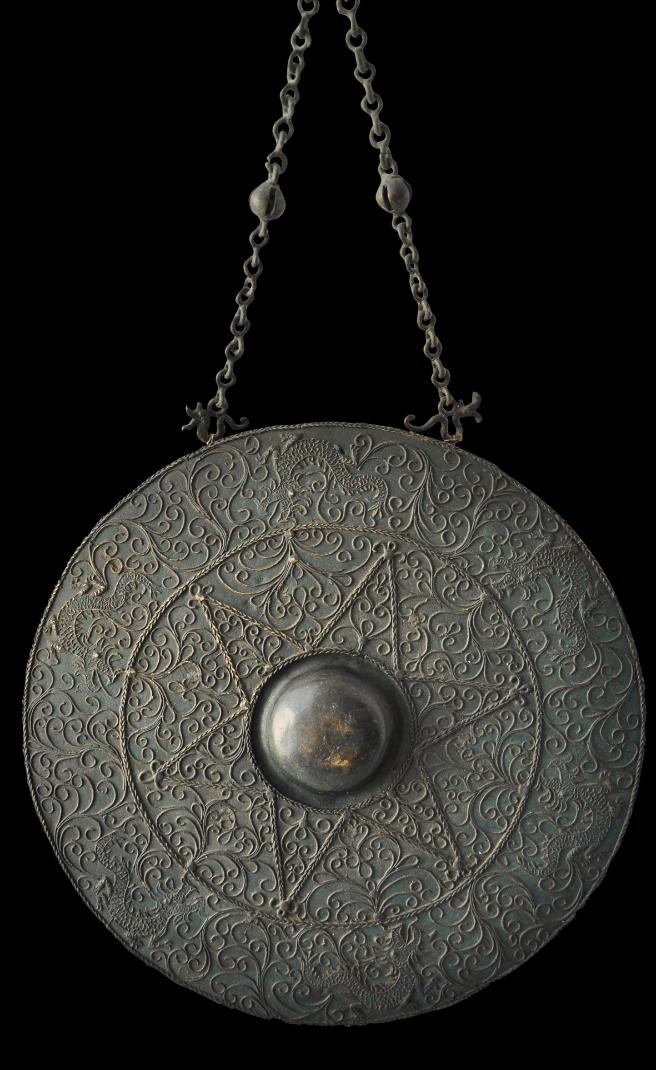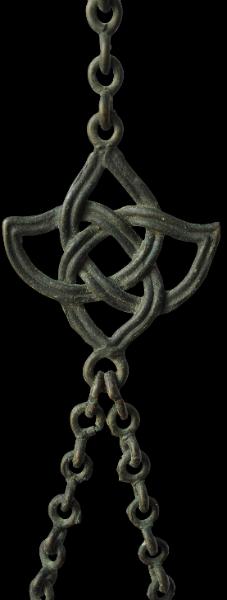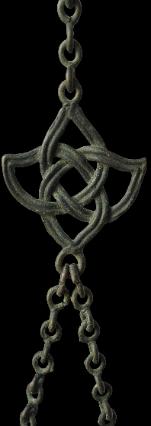
Tawak-tawak Brass Gong – Borneo, Sarawak, Brunei
Large Brass Gong (Tawak-tawak)
Sarawak (Malaysia) or Brunei
18th-19th century
diameter: 45.5cm, width: 11cm, length of chain: 87cm
This gong or tawak-tawak is typical of brasswork from Sarawak or Brunei on the island of Borneo. Cast using the lost wax process, it is elaborately decorated in applied overlay work with six dragons amid scrolling and interlocking vegetal decoration around a six-pointed star which has a large, plain central boss at its centre. The particularly prominent central boss and wide rim are typical of Malay gongs compared with Thai and Burmese gongs that are flatter and more shallow. The original chain incorporates two stylised dragons, a pair of open-work beads, and a cast Buddhistic endless knot.
The elaborate decoration on this gong compares with Malay brassware from peninsular Malaysia which on the whole is far more utilitarian, subdued and in keeping with Islamic prohibitions on figurative art.
Tawak-tawak once were used as signal gongs to call people together. They tended not to be used as part of a gamelan orchestra as in nearby Indonesia. Gong smiths, like kris smiths, worked in an atmosphere of magic and incantation. Some gongs were believed to be protected by supernatural beings (Singh, 1985).
Extant examples of old brassware from Brunei and elsewhere on the island of Borneo frequently exhibit strong Chinese influence such as dragons despite Islam being Brunei’s main religion today. The Chinese influence is apparent in this gong with its dragons and the endless knot motif incorporated with the hanging chain.
Children’s stories that are still told in Brunei and Borneo feature tales of Chinese princes and dragons. One tells of a dragon that lives atop Mount Kinabalu (Borneo’s highest mountain) where it guards a magnificent precious stone the size of a peacock’s egg. The Emperor of China hears about the stone and tells his three sons that whichever one of them brings back the stone will be made his heir; the other two will be killed. One son manages to trick the dragon and captures the stone. But the other sons lie to their father that they were the ones to take the stone. Ultimately, the Emperor discovers this deception and the wayward sons escape China, one of whom returns to Brunei and founds a princely dynasty there.
A gong of similar form is in the collection of the National Museum of Singapore, another is in the British Museum, and a related gong and chain, in the collection of the National Gallery of Australia (NGA), is illustrated in Maxwell (2010, p. 61). The NGA example is attributed to the eighteenth century.
References
Chin, L., Cultural Heritage of Sarawak, Sarawak Museum, 1980.
Maxwell, R.,
Life, Death & Magic: 2000 Years of Southeast Asian Ancestral Art, National Gallery of Australia, 2010.
Singh, B.,
Malay Brassware, National Museum of Singapore, 1985.
Provenance
UK art market
Inventory no.: 1252
SOLD
See more Malay brassware here
.
to see another example.







